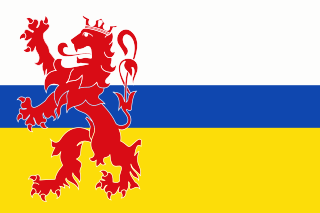
Limburg is the southernmost of the 12 provinces of the Netherlands. It is in the southeastern part of the country, stretched out from the north, where it touches the province of Gelderland, to the south, where it internationally borders Belgium. Its northern part has the North Brabant province to its west. Its long eastern boundary is the international border with the German state of North Rhine-Westphalia. Much of the west border runs along the River Maas, bordering the Flemish province of Limburg, and a small part of the Walloon province of Liège. On the south end, it has borders with the Flemish exclave of Voeren and its surrounding part of Liège, Wallonia. The Vaalserberg is on the extreme south-eastern point, marking the tripoint of Netherlands, Germany and Belgium.
Regiment Limburgse Jagers is a light infantry regiment in the Royal Netherlands Army. It is named for the Dutch province of Limburg, and currently serves in the infantry role as part of 13 Motorized Brigade.

The Rur or Roer is a major river that flows through portions of Belgium, Germany and the Netherlands. It is a right (eastern) tributary to the Meuse. About 90 percent of the river's course is in Germany.
The Iron Rhine or Steel Rhine is a partially nonoperational freight railway connecting the port of Antwerp (Belgium) and Mönchengladbach (Germany) by way of Neerpelt and the Dutch towns of Weert and Roermond.

Petrus Josephus Hubertus (Pierre) Cuypers was a Dutch architect. His name is most frequently associated with the Amsterdam Central Station (1881–1889) and the Rijksmuseum (1876–1885), both in Amsterdam. More representative for his oeuvre, however, are numerous churches, of which he designed more than 100. Moreover, he restored many monuments.

Limburg was one of the provinces of the United Kingdom of the Netherlands and later Belgium. The province existed for the duration of the United Kingdom, from 1815 to 1830, and for the first years after the Belgian independence, from 1830 to 1839. When King William I signed the Treaty of London in 1839, the province was split into a Belgian, and a Dutch part, the new Duchy of Limburg.

The Roman Catholic Diocese of Roermond is a Latin diocese of the Catholic Church in the Netherlands. The diocese is one of the seven Roman-Catholic suffragan dioceses in the ecclesiastical province of the Metropolitan Archbishop of Utrecht. The territory of the diocese covers the Province of Limburg.
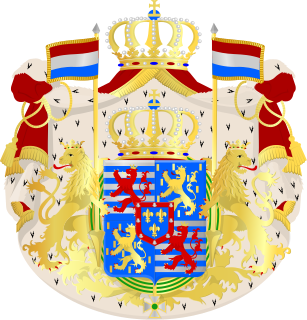
Prince Jean of Luxembourg, the second son of Jean, Grand Duke of Luxembourg and Princess Joséphine-Charlotte of Belgium. He is the twin brother of Princess Margaretha. He frequently goes by the name of Jean Nassau.
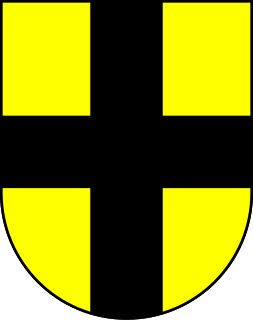
The Diocese of Aachen is one of 27 dioceses in Germany and one of the six dioceses in the ecclesiastical province of Cologne. The incumbent bishop is Helmut Dieser, who was appointed by Pope Francis on 23 September 2016. The bishop's seat is Aachen.

The Arrondissement of Maaseik is one of the three administrative arrondissements in the Province of Limburg, Belgium. It is not a judicial arrondissement. The municipalities of Bocholt, Bree, Kinrooi, Meeuwen-Gruitrode, Dilsen-Stokkem and Maaseik, are part of the Judicial Arrondissement of Tongeren, while the rest of its municipalities are part of the Judicial Arrondissement of Hasselt.

The Meuse–Rhine Euroregion is a Euroregion created in 1976, with judicial status achieved in 1991. It comprises 11.000 km² and has around 3.9 million inhabitants around the city-corridor of Aachen–Maastricht–Hasselt–Liège. The seat of the region has been in Eupen, Belgium since 1 January 2007. Within a wider context, the region is part of what is called the Blue Banana European urbanisation corridor.
The Arrondissement of Roermond was an arrondissement of the United Kingdom of the Netherlands until the Treaty of London in 1839. It was a part of the Province of Limburg, which also included the Hasselt and Maastricht. It was centred on the city of Roermond.

The 2010 Eneco Tour was the sixth edition of the Eneco Tour cycling stage race. It took place from 17 August to 24 August 2010 in the Benelux. Like the previous years, parts of the Netherlands and Belgium were covered. It was part of the UCI World Ranking. It began with a short individual time trial in Steenwijk and ended with a longer one in Genk.
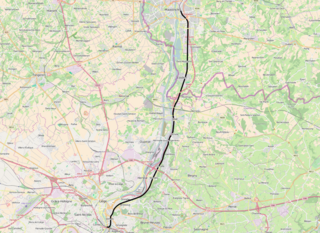
The Liège–Maastricht railway is a railway line running from Liège in Belgium to Maastricht in the Netherlands. The line was opened in 1861.
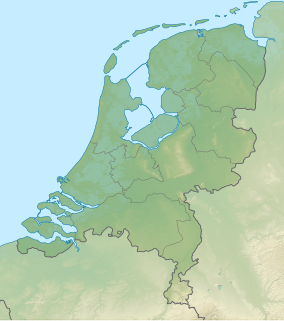
The 1992 Roermond earthquake occurred on 13 April, around 3:20 AM with a moment magnitude of 5.3 and a maximum Mercalli intensity of VII. Striking on the Peel Boundary Fault, a normal fault near Roermond, it was the strongest recorded earthquake in the Netherlands and in Northwestern Europe, and caused substantial damage to older buildings in the Netherlands and adjacent countries of Belgium and Germany. A series of aftershocks followed.
General elections were held in Belgium on 29 August 1831. They were the first elections to the new bicameral parliament, as instituted by the Belgian Constitution adopted in February 1831.
Partial legislative elections were held in Belgium on 11 June 1839. In the Senate elections Catholics won 27 seats and Liberals 12. Voter turnout was 66.4%, although only 23,661 people were eligible to vote.
Maaseik was a constituency used to elect a single member of the Belgian Chamber of Representatives between 1839 and 1900. It replaced Roermond as a constituency for the province of Limburg when that city passed to the Kingdom of the Netherlands as a result of the Treaty of London. The first member from Maaseik had been elected from Roermond in 1837.














